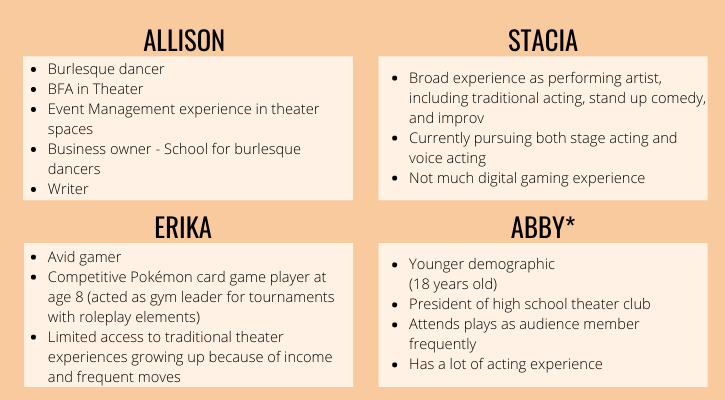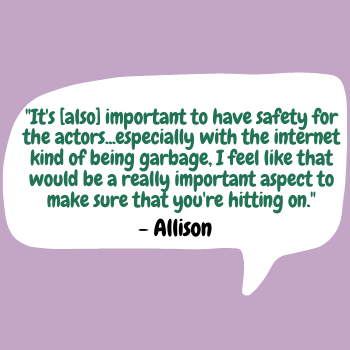This is part of a series of posts in conjunction with GAM 550: Incubation Studio, a graduate level course within DePaul University’s MFA Game Design program. These posts will follow my process in incubating a design concept to bolster engagement with performance arts, with a particular focus on how to integrate theatrical practices within digital game spaces.
In my last post, I defined my initial design concept and discussed the role that design research will play as I develop my ideas further. The first step along that path is talking to people (stakeholders) who have a relevant connection or vested interest in the kind of theatrical gameplay experience I’m hoping to make. I started by creating a quick stakeholder map to identify different categories of people who I might need to speak with.

My stakeholder map formed itself pretty easily into a few main categories: Performers (voice actors, stage actors), Makers (playwrights, game writers, casting directors, game designers), Spaces/Logistics (theaters/venues, event hosts, servers/web hosts, box offices), and Consumers (gamers, streamers, stream audiences). My stakeholder map also indicates that “gamers” could fall under either the Consumer or the Performer category, particularly in considering the thin line between play and performance that my project suggests.
Interview Method
After completing my stakeholder map, I considered possible connections within my network who could fall within the map’s guidelines and also reasonably meet to speak virtually within a couple week’s time. I originally identified three candidates (last names omitted for privacy): Allison, Erika, and Stacia. I was able to meet virtually with both Allison and Erika within my initial timeframe, but Stacia’s schedule is a bit more complicated so we ended up meeting slightly later on. As such, I decided to also speak with Abby (my younger sister) for an added perspective from the acting side of things. Ultimately, I was able to speak with all four interviewees, whose expertise and relevant experiences are outlined below:

For each of my interviews, I took a more conversational approach that allowed me to explore areas of interest as they arose. I did, however, start each interview by explaining the concept that I had in mind and also asking what experiences and background each interviewee had that they felt were relevant. I was loosely aware of each participant’s background prior to arranging the interview, but I would hardly consider my knowledge encyclopedic for any of them (except perhaps for my sister). From there, I generally proposed an initial question or prompt to get the conversation started and allowed things to flow in whatever direction made sense.
I did have a checklist of areas that I definitely wanted to talk about with each participant so that I could keep the conversation from stagnating and make sure to address problems and uncertainties that I had already identified for my design concept. For example, I made sure to ask Stacia about how she might approach acting in a digital space differently than she would in a physical one, and I asked Allison to talk about what her approach would be in managing an entirely online event.
In general, I found that my approach unearthed a lot of interesting talking points and my concept was pushed to entirely new levels as a result.
Results and Takeaways
1. Community management and moderation must be a consideration at the outset.

Community management came up almost immediately in my conversation with Allison, who was drawing on her experience managing events in theater spaces. She was keenly aware of how important it is to protect both the audience members and the performers in any theatrical experience, particularly when interactive elements are involved. Because the internet can sometimes be a very toxic environment and the anonymity of digital personas emboldens aggressive behavior, Allison was especially focused on how to prevent participants from being harmful and/or inappropriate. A potential solution could be to limit player interactions to scripted dialogue options as opposed to allowing them to type responses. Even so, because the event would be unfolding live, it would probably be beneficial to incorporate someone in a moderator role to ensure a stable and safe play environment for everyone involved.
2. It’s important to think about the relationship between play and performance.

Going into this project, I was already interested in the connection between play and performance, but my interviews helped to re-contextualize that consideration, especially from the lens of how performance is a type of play. Before, I had been thinking mostly about how players are performing a type of role every time they play a game, but I hadn’t considered that performers, even in traditional settings, are fully engaged in playfulness as well. In her interview, Stacia mentioned that it would be important for her as a performer to be able to play the game from the player perspective prior to taking on the role of an NPC. For her, it’s helpful to be able to understand things from the audience’s point of view. Meanwhile, Abby, who is an active game player in addition to being an actor, spoke to how she brings her acting self to her play experiences. She fully immerses herself in the role of her character and focuses more on how to further her own character storyline than anything else.
3. Uncertainty is a powerful tool for narrative strength in digital spaces.
While I was speaking to Erika about whether or not she would enjoy the type of game experience I am hoping to create, she spoke a lot about the exhilaration (both on the positive end of being excited and the negative end of being a little uncertain/scared) of being in a space with undefined boundaries. In a typical game, even when it is highly choice-based, there’s only as many outcomes as the game creator has thought to include. In a live game setting with performers taking on the role of NPCs, there’s an added layer of uncertainty and anonymity that may make the game space feel more alive for players. Having a play space with actors could make players feel like anything could happen, even if that isn’t entirely true. It’s something to be cognizant of, both for how it could be leveraged for narrative power but also in how it could make players feel uncomfortable or insecure if handled improperly.
